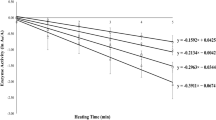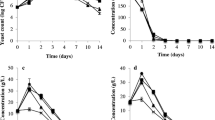Abstract
Cactus pear (Opuntia ficus-indica) juice with a total soluble solids content of 15.94 °Brix was fermented using the wine yeast Saccharomyces cerevisiae. A 94.54% conversion of fermentable sugar was achieved with an ethanol production of 55.3 ml/l. The pigment degradation was found to be 17% at the end of the time allowed for fermentation. However, the fermentation had actually ceased due to depletion of fermentable sugars after 12 h, a point at which only 9.4% pigment degradation was observed and there was no further total soluble solids degradation. The thermal stability of the yellow-orange pigment of the fermented juice was determined as a function of temperature at pH 5.0. The kinetic experiments were carried out at three different temperatures, 50, 70 and 90 °C. For a pseudo-first order thermal degradation rate the reaction rate constants were determined to be 0.0066, 0.0206 and 0.1244 min–1 for temperatures of 50, 75 and 90 °C, respectively. The activation energy was calculated as 15.71 kcal mole–1. The fermentation process did not affect the thermostability of the pigment extract.
Similar content being viewed by others
Author information
Authors and Affiliations
Additional information
Received: 10 January 2000 / Revised version: 31 March 2000
Rights and permissions
About this article
Cite this article
Turker, N., Coşkuner, Y., Ekiz, H. et al. The effects of fermentation on the thermostability of the yellow-orange pigments extracted from cactus pear (Opuntia ficus-indica). Eur Food Res Technol 212, 213–216 (2001). https://doi.org/10.1007/s002170000247
Issue Date:
DOI: https://doi.org/10.1007/s002170000247




